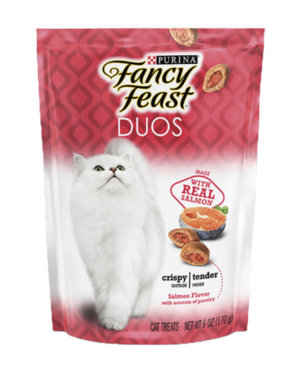Fancy Feast Duos Salmon Flavor With Accents Of Parsley Review
PawDiet has been helping pet owners since 2015. To fund our efforts, articles may include affiliate links; if you buy something through a link, we may earn a commission.
Review of Fancy Feast Duos Salmon Flavor With Accents Of Parsley
According to our most recent data, this product is intended for intermittent or supplemental feeding only.
Review of Ingredients
In our review of Fancy Feast Duos Salmon Flavor With Accents Of Parsley, we'll examine all 22 ingredients and highlight the nutritional contribution of each ingredient.
While the first few ingredients typically dominate the recipe's composition, ingredients in small quantities can still have a meaningful impact on the overall nutritional profile of the recipe.
Brewers Rice is a highly digestible carbohydrate source that provides cats with a source of energy and supports healthy digestion.
Chicken By-Product Meal is a concentrated source of protein, containing essential amino acids and nutrients that support your cat's overall health, muscle development, and growth.
Corn gluten meal is a by-product of corn processing and is used as a source of protein. However, it's not as beneficial as meat-based proteins.
Animal fat (preserved with mixed tocopherols) is a rich source of energy and essential fatty acids that support your cat's skin, coat, and immune system health.
Glycerin is a natural, plant-based ingredient used as a humectant in cat food. It helps to retain moisture, keeping the food fresh and palatable while also providing a source of energy for your cat.
Natural Chicken Flavor is a natural flavoring that enhances the taste of your cat's food, making it more palatable and enjoyable. It ensures that your cat receives a delicious and satisfying meal every time.
Salmon is a high-quality source of protein and omega-3 fatty acids, which support your cat's muscle development, healthy skin and coat, and overall well-being.
Animal Digest is a concentrated source of animal proteins, providing essential nutrients for your cat. It enhances the flavor of the cat food, making it more palatable and appealing to your cat's taste buds.
Wheat starch is a carbohydrate source that provides energy for your cat, while also helping to form the texture of the cat food.
Phosphoric acid is used in small amounts as a pH adjuster and preservative to ensure optimal shelf life and safety for your cat's food.
Natural flavor enhances the palatability of the cat food, making it more appealing to finicky eaters.
Artificial flavors are used to enhance the taste of cat food, making it more appealing to your pet.
Dried Brewers Yeast is a rich source of B-vitamins, amino acids, and minerals that support your cat's overall health. It also helps maintain a healthy skin and coat, as well as promoting a strong immune system.
Salt is added in small amounts to cat food to help maintain electrolyte balance and support healthy nerve and muscle function.
Added Color is used to make cat food visually appealing to pet owners. While it does not offer any nutritional benefits, it is typically safe for consumption and regulated by the FDA.
Parsley Flakes can add a fresh flavor to cat food and provide some vitamins and minerals. However, their nutritional benefits for cats are limited. Consult your veterinarian before introducing parsley flakes into your cat's diet.
Red 40 is a widely-used artificial food colorant that adds an appealing color to your cat's food, making it visually more attractive.
Citric acid is a natural preservative that helps maintain the freshness and quality of your cat's food while also providing a tangy flavor that can stimulate your cat's appetite.
Yellow 6 is a synthetic food coloring used to give cat food an appealing appearance. Though considered safe in regulated amounts, it does not provide any nutritional benefits.
BHA (Butylated Hydroxyanisole) is a synthetic antioxidant used as a preservative in some cat foods to maintain freshness and extend shelf life. However, it is a controversial ingredient due to potential health concerns, and many pet owners prefer to avoid it in their cat's diet.
BHT (Butylated Hydroxytoluene) is a synthetic antioxidant used to preserve the freshness of fats and oils in cat food. It helps maintain the nutritional quality of the food and extend its shelf life.
Calcium carbonate is a common ingredient in cat food, used as a source of dietary calcium to support bone health and several key metabolic functions.
Review of Guaranteed Analysis
The guaranteed analysis value of Crude Protein (min) of 26.00% is likely contributed by several ingredients with high protein content. The chicken by-product meal, corn gluten meal, and salmon are the primary sources. Chicken by-product meal is a concentrated form of protein because it's made from rendered parts of poultry which are not typically consumed by humans. Corn gluten meal, another high-protein ingredient, is a by-product of the corn milling process. Salmon, being a fish, is naturally rich in proteins and also provides the specific flavor for this pet food.
Crude Fat (min) of 13.00% is mainly attributed to the animal fat preserved with mixed-tocopherols and possibly some from the chicken by-product meal. Animal fats are commonly used in pet foods to provide essential fatty acids and to make the product more palatable. The mixed-tocopherols, a form of Vitamin E, act as a natural preservative to keep the fat from going rancid.
The Crude Fiber (max) of 2.00% is relatively low, which is typical for cat foods as cats require a diet low in fiber. Ingredients contributing to the fiber content include brewer's rice and wheat starch. Brewer's rice is the small milled fragments of rice kernels that have been separated from the larger kernels of milled rice, and wheat starch is a carbohydrate that can contain some dietary fiber. These ingredients are likely included to provide a source of carbohydrates and to help bind the kibble together, but they also contribute a small amount of fiber to the diet. The parsley flakes may also contribute a negligible amount of fiber.

